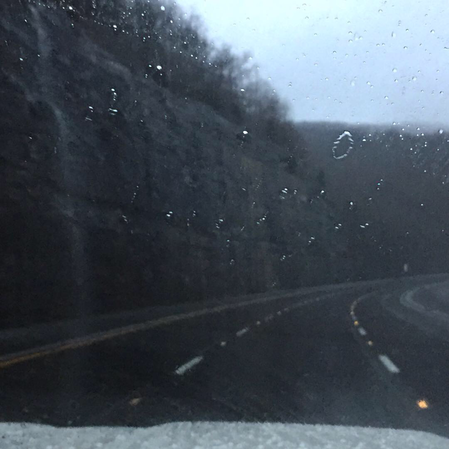 Rainy Waterfall On That Steep Monteagle Grade Rainy Waterfall On That Steep Monteagle Grade Sam Burnham, Curator @C_SamBurnham We’ve got a new sailor in our family, effective last Friday. So prudence required a trip to watch the Pass-In-Review ceremony, the official graduation of US Navy boot camp. Between school schedules, work schedules, travel schedules, TSA regulations, checked baggage restrictions, and the need to carry our favorite exile as much South with as absolutely possible, a decision was made. We needed a pack mule. That meant the ladies would fly in with their carry on bags and establish a base camp. The guys would load the required sundries into the trusty pickup, close the bed cover and hit the road. Sounds easy enough. From our home base we chose the route that carried us over Lookout Mountain, into Alabama, back into Dade County (Free State of Dade) and then back into Tennessee at the disputed area between the enforced state line and the true boundary at the 35th parallel. This entirely cut out the Chattanooga evening rush hour. Like Bandit Darville some 56 years before us, we hit Monteagle in a drivin’ rain but we made it up and over without major incident. The rain continued through Nashville, Bowling Green, and Louisville.
 It Was Snowing It Was Snowing The next incident is a little more controversial. While placing blame with neither the driver nor the navigator, I’ll say a wrong turn was made. We wound up on a surface street in downtown Indianapolis. It was snowing. We encountered one other car. It’s 2 am. Again, it was snowing. Somehow in an abandoned city we still wound up sitting at every red light on N. West St. Did I mention it was snowing? Besides that one other misguided soul the only humans we encountered were trucks with the Indiana DOT patrolling I-65 for snow and ice. After thus event we began to reason with ourselves. “It’s only this far to our destination, it’s already this late, it doesn’t make much sense to stop for the night at this point...” so we rambled on. 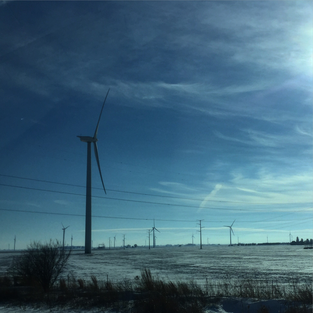 Much Less Mysterious In The Daylight Much Less Mysterious In The Daylight Between Lafayette and Remington we found ourselves immersed in a sea of synchronized red warning lights atop what appeared to be small radio towers. The lights would slowly appear and then fade away in perfect unison. What in the world was going on? As the mystery grew so did the sea of lights, laid out in rows, fade in, fade out, repeat. There was a conspiracy theory proposed from the back seat - something about nuclear missile deployment and detection. But that guy is predisposed to comical conspiracy theories and fatigue and was setting in. Our ability to reason was compromised, albeit just slightly at this point. The more scientific of the two back there finally caught a glimpse in the darkness. Wind turbines. Hundreds of them. 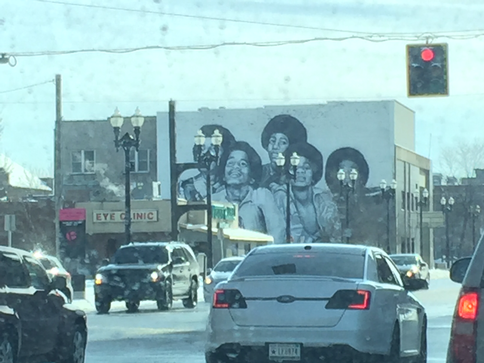 Under The Sun (And Using The Correct Detour) Gary Is A Little Less Scary Under The Sun (And Using The Correct Detour) Gary Is A Little Less Scary Then the craziest part. Somewhere between Gary, Indiana and Chicago, we wound up on another surface street. The truck’s GPS kept spitting out directions but they were to a road that doesn’t exist yet. Then it picked up a new path. I was checking it against Google Maps on my phone. The area was a strange mesh of heavy industry and light residential. The entire scene was a combination of Fitzgerald’s Valley of Ashes and the Emelio Estevez/Dennis Leary thriller Judgement Night. As I followed on my map, the road the GPS had us take just wasn’t there. “Yes, keep following,” I said, “this is right. We’re good.” But I was lying. I knew in my heart that this was it. We were lost in a pile of petroleum storage, steel mills, and rough neighborhoods. We were all going to see Jesus. Whether it was an avoidable industrial incident or one of those famous Chicago shootings, this was the end. We passed a “No Thru Traffic” sign and I took a deep breath as we approached a dirt berm at the road’s dead end - emphasis on ‘dead.’ Then, out of nowhere, an on ramp appeared in our headlights just to the right, we took it and boom, we were on I-90. They say it’s always darkest right before the dawn. Our most dire moment came at about 4 am on a Thursday. We’d all been up around 22-24 hours, give or take. But we lived. The sun rose on the frozen landscape and we lived to see it. And I’ve never been more happy to have been wrong.
2 Comments
 About that Gillette ad... I think I'm seeing what they were trying to say. There’s a standard that we as a society should hold men to. There is an expectation for the conduct of a man that does often go unmet. I think there is a communication breakdown when it comes to the topic of masculinity and proper male role models. With the presence of a radical feminist movement who frequently uses misandry and a definition of “toxic masculinity” that leaves no place for strong and effective men in our society, people react when they see yet another assault on men. I think Gillette could have communicated their message better and I think people could have listened better. My takeaway at this point, after some thought and reflection is this: Not all criticism of male behavior is intended to drag all men down. Not all feminists are radical misandrists. Not all masculinity is toxic. In fact, true masculinity is never toxic. Masculinity is about strength, leadership, and being a role model for young men. It’s about using strength in a constructive and protective way. The men who stormed the beaches of Normandy weren’t bullies coming to harass the Germans. They were there to defend Western Civilization from a toxic usurper. There’s a line that separates playful roughhousing and malicious bullying. There’s a line between the idea of dating and courtship and the menace of sexual harassment- and BOTH sides on the argument need to understand that. I’ve spent almost half my life, thus far, raising three men. Just yesterday the oldest became a United States Navy sailor. He and his brothers make me proud beyond words. They are strong, have courage in their convictions, expect the best from others, despise bullying, respect ladies, and offer help to those in need. They are gentlemen. They're gentlemen because we’ve raised them that way. I have a guide that I follow. It was composed using the teachings of Christ, the understanding of what should be expected of a man, and by a man who was tasked with mentioning and leading men. He’s often demonized today. His effect on the American left is so strong they take a few associative flaws and attempt to discard him as a whole. It is striking that when held up against him, any male leader in the American left pales in comparison.  General Robert Edward Lee General Robert Edward Lee General Robert Edward Lee, who was born on this day in 1807 gave us his timeless Definition of a Gentleman. It is the standard I’ve held my boys to. It is the standard we need to hold all American men to today. It is the line between true masculinity and the toxic pseudo-masculinity that would poison our entire society. No matter how far they march, how hard they try, this issue will never be solved by feminism. It can only be solved by men who fit this definition expecting other men to fit it as well. I’ll conclude with his definition in its entirety: "The forbearing use of power does not only form a touchstone, but the manner in which an individual enjoys certain advantages over others is a test of a true gentleman. The power which the strong have over the weak, the employer over the employed, the educated over the unlettered, the experienced over the confiding, even the clever over the silly--the forbearing or inoffensive use of all this power or authority, or a total abstinence from it when the case admits it, will show the gentleman in a plain light The gentleman does not needlessly and unnecessarily remind an offender of a wrong he may have committed against him. He cannot only forgive, he can forget; and he strives for that nobleness of self and mildness of character which impart sufficient strength to let the past be but the past. A true man of honor feels humbled himself when he cannot help humbling others." Sam Burnham, Curator @C_Samurnham 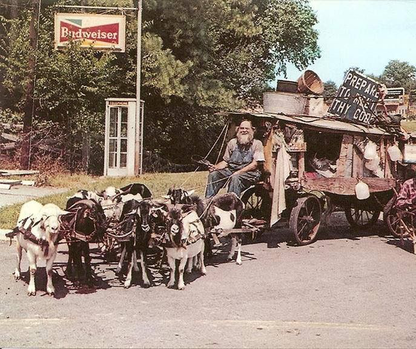 Ches McCartney, The Legendary Georgia Goat Man Ches McCartney, The Legendary Georgia Goat Man James Calemine’s latest dispatch at Snake Nation Press has me thinking about the ways the world, specifically The South, has changed just during my lifetime. Change is inevitable, no doubt, and it is even beneficial at least some of the time. Some change really is progress. Some progress really is improvement. But the amazing photo of the Goat Man, a man out of time in his own era is an even more bizarre vision today. The man who is still a subject of stories and legends some 20 years after his death would likely have no place in our modern time. He was a native of Iowa who was once married to a Spanish knife thrower 10 years his senior. He left her and their sideshow act after the Depression broke them. An injury back in Iowa led to a religious conversion that, understandably, led him to Georgia. He’d leave out in that ramshackle wagon, pulled by his trusty team of goats and travel all over. He didn’t just wander Georgia. His stories are told in other states and he himself claimed he had visited all of the lower 48 states. He rarely bathed, he lived off goat milk and whatever else he came across. He wore goat skins and preached fiery messages of repentance in the makeshift revival services in every town he stopped in. He left his wooden plank signs, painted with repentance messages, nailed to trees and fence posts in his wake as he wandered. He was somewhere between a picture and a caricature of John the Baptist. In the long run, he was a character in a large story that is Southern Culture. He was one of many unique and odd folks who inspired a thousand characters in books and stories by people like William Faulkner, Flannery O’Connor, Eudora Welty, and others. People like the Goat Man made the Southern Gothic literary genre possible. 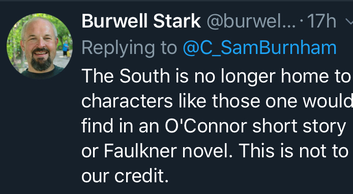 But today our roads are far too busy for a smelly old man on a goat wagon. Our towns are far too refined for his unkempt campsite. Our discourse is far too tolerant to tolerate his fiery sermons. We don’t have the time, the patience, or the curiosity to be bothered by him or his kind. But he’s not alone. Burwell Stark summed it up well on Twitter: “The South is no longer home to characters like those one would find in an O'Connor short story or Faulkner novel. This is not to our credit.” While there admittedly are still some wild characters to be found here and there, we’ve lost both the volume of them and the fascination we have for them. A man traveling the road in a goat wagon it a traffic hazard, a nuisance, he’s holding up progress, he’s not living in 2019. Do we ever ask ourselves if we’re making 2019 the kind of place we wish to inhabit? This is why we lack modern folk heroes. The Legendary Georgia Goat Man is one of thousands of characters we no longer have. He’s one of thousands we don’t currently deserve. |
Sam B.Historian, self-proclaimed gentleman, agrarian-at-heart, & curator extraordinaire Social MediaCategories
All
Archives
November 2022
|





 RSS Feed
RSS Feed
